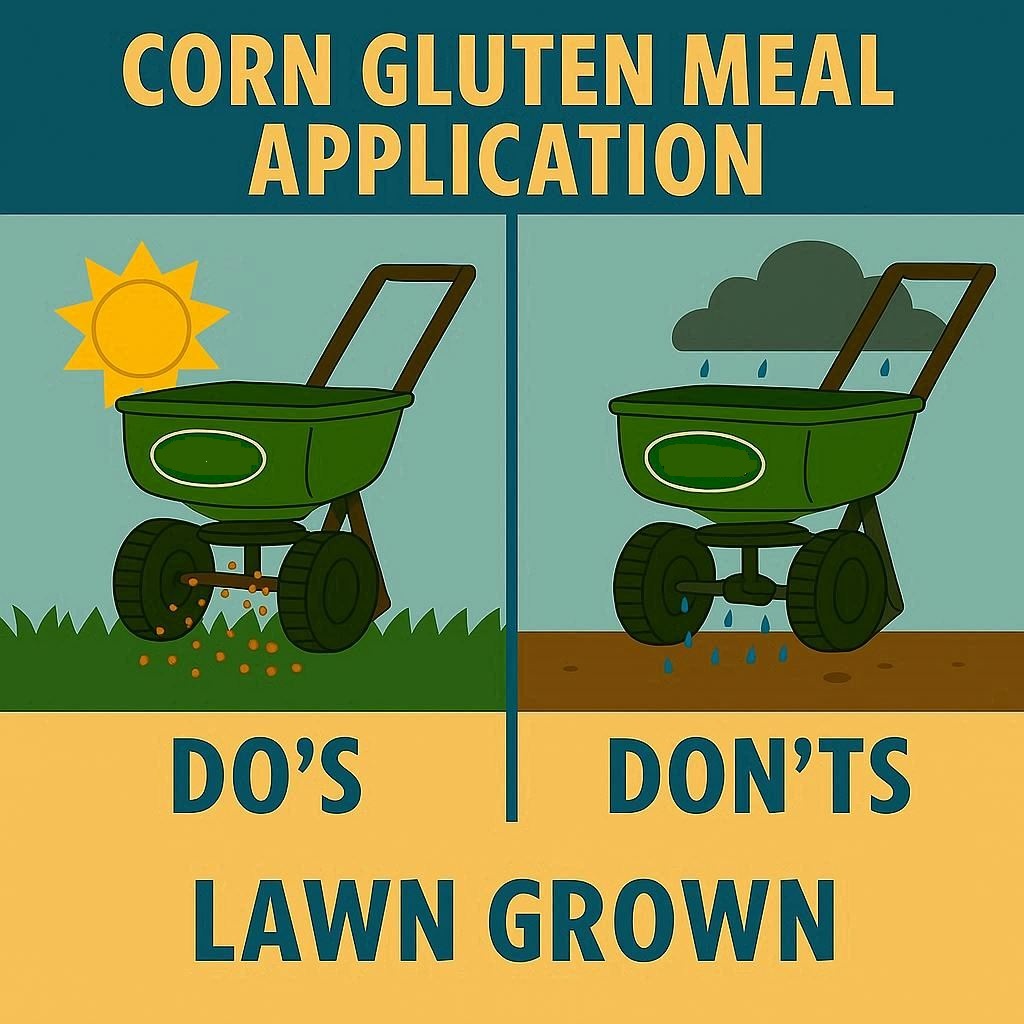
When I first heard about corn gluten meal (CGM) as a natural weed preventer, I was skeptical. But after using it consistently on my lawn and garden, I realized that when applied correctly and at the right time, it can be an effective, environmentally friendly way to manage weeds and improve soil health.
This guide walks you through when to apply corn gluten meal, how to use it properly, and the do’s and don’ts that make all the difference between success and frustration.
🌿 What Is Corn Gluten Meal?
Corn gluten meal is a natural byproduct of corn processing—it’s what’s left after extracting starch and syrup from corn kernels. It contains about 10% nitrogen, which makes it a mild organic fertilizer while also serving as a pre-emergent weed suppressant.
Discovered accidentally in the late 1980s by Dr. Nick Christians at Iowa State University, CGM was found to inhibit root formation in seedlings, preventing weed seeds from growing—if applied under the right conditions.
What It Does:
- Prevents seed germination (acts as a natural pre-emergent herbicide).
- Adds slow-release nitrogen to your soil.
- Improves turf density and grass color over time.
- Enhances soil microbial activity, promoting a healthy lawn ecosystem.
What It Doesn’t Do:
- It does not kill existing weeds.
- It won’t work immediately — results take consistent, seasonal use.
🕒 When to Apply Corn Gluten Meal
Timing is everything with corn gluten meal. The product only works if applied before weed seeds germinate — not after.
🌸 Spring Application (Most Important)
Apply in early spring, right before soil temperatures reach about 55°F (13°C) — that’s when crabgrass and other weeds begin to germinate.
In many regions, this coincides with forsythia shrubs blooming, a natural signal that it’s time to apply.
- Northern states: Mid-March to mid-April
- Southern states: Late February to early March
🌼 Rule of thumb: If you see dandelions blooming, you’re late for pre-emergent control.
🍂 Fall Application (Bonus Round)
A second application in late summer or early fall (August–September) can prevent winter annual weeds like chickweed and henbit.
This also gives your lawn an extra nitrogen boost heading into winter dormancy.
🌱 For New Lawns
Never use corn gluten meal when you’ve just seeded. It prevents all seeds from germinating, including grass seed.
Wait at least 6–8 weeks after applying CGM before reseeding your lawn.
⚙️ How to Apply Corn Gluten Meal (Step-by-Step)
Corn gluten meal is available in powder, granule, or pellet form. Here’s how I apply it for best results:
Step 1: Check the Weather
Choose a dry day with no rain in the next 24 hours. Rain too soon after spreading can wash away the product before it binds to the soil surface.
Step 2: Mow and Clean
Mow your grass to normal height and remove leaves, sticks, or debris. Corn gluten meal needs direct soil contact to be effective.
Step 3: Spread Evenly
Use a broadcast spreader or hand spreader to distribute the product evenly.
- Recommended rate: 20 pounds per 1,000 sq. ft. for pre-emergent control.
- For nutrient improvement only: 10–12 lbs per 1,000 sq. ft. is fine.
Walk slowly and slightly overlap each pass to prevent skips.
Step 4: Water Lightly
After applying, water lightly (¼ inch) to activate the product. This helps it form a protective barrier in the top layer of soil where weed seeds germinate.
Avoid overwatering — heavy rainfall can dilute and wash it away.
Step 5: Let It Dry
After the initial watering, keep the lawn dry for 5–7 days. This dry period is crucial because it prevents new seeds (including weeds) from sprouting.
Step 6: Reapply
For consistent results, apply twice a year — once in early spring and again in late summer.
🌤️ Best Conditions for Application
To maximize corn gluten meal effectiveness:
| Condition | Ideal Setting |
|---|---|
| Soil temperature | 50–55°F for weed prevention |
| Soil moisture | Lightly moist, not soggy |
| Weather | Dry for 2–3 days post-application |
| Frequency | Every 6–8 weeks or twice yearly |
| Lawn type | Established turf, not new seedings |
If it’s too wet, too cold, or too late in the season, it won’t stop weeds effectively.
🌾 Corn Gluten Meal as Fertilizer
Beyond weed control, CGM acts as a natural nitrogen source.
Each application adds about 1–2 pounds of nitrogen per 1,000 sq. ft., promoting lush green grass without the chemical burn risk of synthetic fertilizers.
Benefits as a Fertilizer:
- Slow, steady nutrient release.
- Improves microbial activity and soil structure.
- Enhances grass color and density naturally.
- Safe for kids, pets, and pollinators.
If your goal is fertilization more than weed prevention, you can use smaller doses (10 lbs per 1,000 sq. ft.) every 6–8 weeks.
⚠️ The Do’s and Don’ts of Corn Gluten Meal
Here’s what I’ve learned the hard way — the dos and don’ts that determine whether CGM works or fails.
✅ DO’s
- Apply before weed seeds germinate.
Timing is critical — once weeds sprout, CGM can’t help. - Apply to established lawns only.
Using it during seeding blocks grass seed germination too. - Use the right amount.
Apply 20 lbs per 1,000 sq. ft. for weed control, not less. - Water lightly, then let dry.
Moisture activates CGM, but too much water ruins it. - Reapply twice a year.
Consistency builds up results over several seasons. - Store properly.
Keep in a dry, airtight container — moisture makes it clump or mold. - Combine with good lawn care.
Mowing high, proper watering, and aeration make your lawn thicker and more competitive against weeds.
❌ DON’Ts
- Don’t use before seeding.
Wait 6–8 weeks after application before planting grass seed. - Don’t expect it to kill existing weeds.
It’s preventive, not curative. Use manual removal or spot sprays first. - Don’t apply in heavy rain or windy conditions.
It won’t stick to the soil or will blow away. - Don’t skip watering after application.
It needs light moisture to activate and form a weed barrier. - Don’t rely on it for one-time results.
It works gradually over multiple seasons of use. - Don’t mix with chemical herbicides.
It defeats the purpose of organic weed prevention.
🌱 Does Corn Gluten Meal Really Work?
Yes — but with realistic expectations.
Corn gluten meal doesn’t eliminate every weed instantly, and its success depends on timing, weather, and consistency.
In my experience, I’ve seen about 50–60% reduction in weeds after consistent spring and fall use for two years. By the third season, my lawn thickened enough that new weeds rarely took hold.
So, if you’re looking for a natural, long-term solution, CGM is effective — just not a quick fix.
🧮 Application Example for an Average Lawn
If your lawn is 2,000 sq. ft.:
- You’ll need 40 lbs of CGM for full coverage.
- Spread it evenly using a broadcast spreader.
- Lightly water (about ¼ inch) immediately after application.
- Avoid rain or irrigation for 5–7 days.
Repeat in early fall for better cumulative results.
🌻 Combining Corn Gluten Meal with Other Lawn Care Practices
For best results, I combine CGM with these eco-friendly habits:
- Core aeration – Improves soil contact and allows nutrients to reach roots.
- Overseeding (at separate times) – Seed new grass in fall if CGM was applied in spring.
- Proper mowing height – Keep grass 3–4 inches tall to shade out weeds.
- Regular watering – Deep, infrequent watering strengthens grass roots.
- Soil testing – Ensure your pH and nutrients are balanced for optimal growth.
By combining these with CGM, your lawn naturally crowds out weeds and becomes healthier over time.
💬 Common Questions
1. How long does corn gluten meal last in the soil?
About 5–6 weeks. It breaks down naturally and releases nitrogen slowly.
2. Is it safe for pets and children?
Yes. It’s 100% natural and non-toxic — safe even right after application.
3. Will it kill crabgrass?
It prevents crabgrass seed germination but won’t kill established crabgrass.
4. Can I mix it with compost or topdressing?
Yes! Mixing with compost adds organic matter while CGM provides nitrogen.
5. What if it rains after I apply?
If rain occurs within 12 hours, reapply a light layer, as it may have washed away.
🌎 Environmental Benefits
Corn gluten meal is a sustainable, renewable resource. Unlike chemical herbicides, it:
- Poses no groundwater contamination risk.
- Doesn’t harm beneficial insects or earthworms.
- Reduces dependency on synthetic fertilizers.
- Supports long-term soil health.
By choosing CGM, you’re helping both your lawn and the planet.
🌾 Final Thoughts
Applying corn gluten meal the right way can transform your lawn into a naturally weed-resistant, nutrient-rich environment. The key is timing, patience, and consistency — it’s not a miracle cure, but it’s an effective organic tool when used properly.
Apply before weeds germinate, keep the soil lightly moist, and repeat each season. Over time, you’ll notice fewer weeds, greener grass, and healthier soil — all without relying on harsh chemicals.
Your lawn will thank you — and so will the environment. 🌿
📚 References
- Iowa State University Extension – Corn Gluten Meal as a Natural Preemergence Herbicide.
- University of Minnesota Extension – Natural Weed Control Options for Lawns.
- Oregon State University – Organic Lawn Fertilizers and Their Effectiveness.
- USDA ARS – Evaluating Corn Gluten Meal as a Preemergence Weed Control.
- Penn State Extension – Organic Lawn and Garden Weed Management.

I’m David man behind Lawn Mowerly; I’ve been dealing with lawnmowers and Tractors with my father since I was a kid. I know every make and model and what each one is capable of and love helping people find the perfect equipment for their needs.
